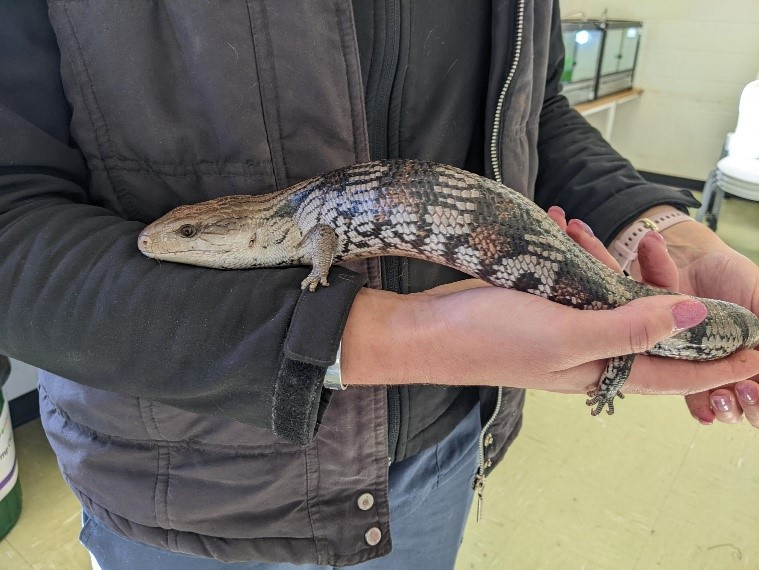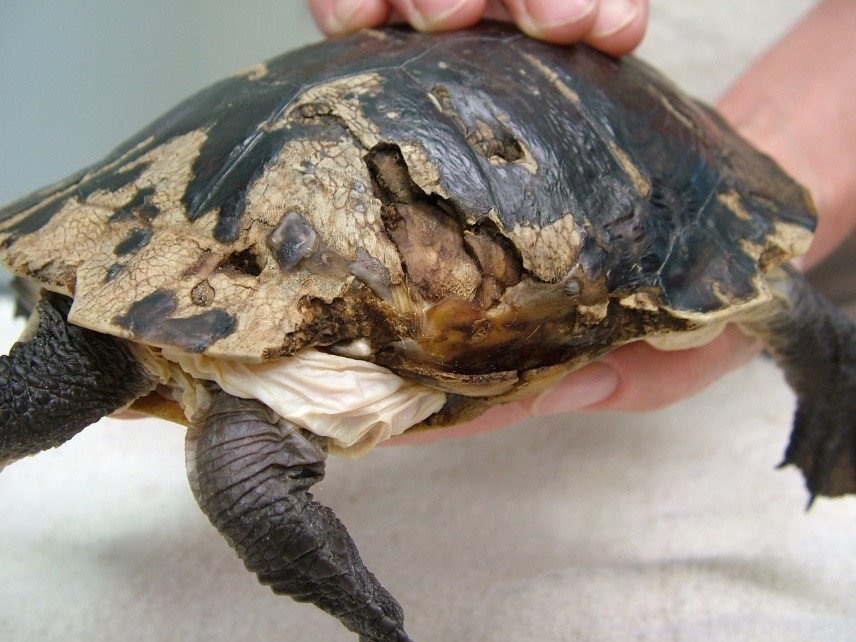
Although it is not always a good idea, some reptile owners allow their reptiles to roam through the house, or at least a few rooms. While this may enrich your reptile’s life, it may also put them at risk of disease, injury, or even death.
What hazards are out there?
This is not a complete list, so if you are in any doubt about something that your reptile has eaten or been in contact with, please contact your reptile veterinarian.
Escape
Open doors and windows are invitations for your reptile to escape to the outside. Do not leave doors and windows to the outside open unless there is a strong screen securely installed. Check these screens regularly for any holes or loose wire that could injure your reptile or allow escape. (If your reptile does escape, you are unlikely to get them back, but they will generally revert to ‘wild behaviour’ and survive.)
Temperature changes
The most likely temperature extreme your reptile may experience while out of their enclosure is cold, especially on tiled or wooden floors or when the air conditioning is on. As their body temperature drops, your reptile will become lethargic, stop eating, and become susceptible to diseases.
Traumatic injuries and suffocation
Many reptiles like to hide under things or find a small “hole” into which they can retreat. With their small size, they can easily go unnoticed and be trapped or injured by moving parts. To prevent these occurrences:
- Always look where you walk. Many reptiles have been injured or even killed from being stepped on.
- When you close a door or cupboard, make sure your reptile is not sitting on top of it or on their way through the opening.
- Do not allow your reptile in rooms where computer printers, electrical tools, vacuum cleaners, or other mechanical devices with moving parts are being used.
- Use caution when using fold-out beds or recliners since reptiles may get underneath them and into the mechanism.
- Before moving or laying anything on the bed covers, laundry basket, or other areas where there are multiple layers of fabric, be sure your reptile has not gotten between the layers.
- Cover all air ducts to prevent a reptile from exploring and becoming lost in the wall or ceiling.
Children
A reptile could be hurt by (or hurt) a child if improperly handled. To keep everyone safe, supervise small children, teach older children how to handle reptiles safely and take into account the temperament and size of the reptile.
Because of the risk of Salmonella, do not allow children under five years of age to handle a reptile. If your children are less than a year old, you may be best to wait till they are older before getting a reptile.
Other pets
You should take extreme care to keep your reptile away from other pets. It is natural instinct for dogs and cats to prey on reptiles. Animal bites can cause severe injuries and be fatal. If your reptile is bitten, always seek veterinary attention immediately.

Sometimes the reverse is true, and a large reptile can be dangerous to your other pets, especially birds and small mammals such as rats, mice, and guinea pigs.
And, as always, there is the ever-present risk of Salmonella.
Some safety guidelines:
- Never leave a loose reptile unattended in a room with another pet, even if they appear to get along well together. It is always better to be safe than sorry.
- Place reptile cages where they cannot be tipped over by inquisitive or predatory behaviours of other pets.
- Cover all aquariums to prevent your reptile from accidentally drowning or drinking the water that may contain infectious organisms or chemicals used to treat the water.
- Keep cat litter boxes out of the reach of reptiles. Ingestion could result in obstructions of the digestive tract.
- Keep water dishes out of the reach of reptiles, since some smaller reptiles can drown in even a small amount of water.
- Keep all flea and tick sprays and pet medications and supplements (especially those that are flavoured or in chewable blocks) out of the reach of reptiles.
Kitchen hazards
The kitchen contains an almost endless number of hazards including:
- Burns from hot burners, open ovens, toasters, coffee pots, kettles, boiling water, or hot cooking oil.
- Drowning in a sink or even a small bowl of water.
- Injuries or entrapment in open appliances, such as dishwashers, freezers, and refrigerators.
- Cuts from sharp objects, such as knives.
- Toxic foods including alcohol, salt, and coffee, tea, colas, and other caffeinated beverages.
The kitchen should be off limits to all reptiles not only for their safety, but also because of the risk of Salmonella from the reptile contaminating food, surfaces, or eating utensils.
Bathroom hazards
Bathrooms can be almost as hazardous as kitchens, and extreme care should be taken if your reptile is allowed in this room of the house.
- Prevent access to water in sinks, bathtubs, toilet bowls, and jacuzzis since drowning could easily occur.
- Keep all medications, including vitamins and supplements, out of the reach of children and pets.
- Keep other potentially poisonous items, such as shaving cream and lotion, hair dyes and permanent solutions, and cleaning supplies (including toilet bowl cleaner) safely stored.
Again, reduce the risk of Salmonella transmission by not allowing your reptile access to the bathroom.
Laundry hazards
The laundry room is another area of the house that poses multiple threats to reptiles.
Use care when placing or removing laundry from baskets in case your reptile may have found the basket to be a good sleeping place.
Keep the doors to the washer and dryer closed and watch very closely as you load and unload the laundry. Reptiles have accidentally been trapped and killed in these appliances.
Keep detergents, fabric dyes and softeners, bleach, and other potentially toxic laundry supplies safely stored out of the reach of children and pets.
Heat sources
Reptiles are always looking for warmth, and this is especially true in a reptile wandering around the house. Burns are a common injury in pet reptiles and can occur from several sources other than kitchen appliances.
- Never allow your reptile in a room where there is an open flame from candles, fondue pots, heated potpourri pots, or other sources.
- Keep your reptile caged when using a space heater or fireplace. Even if glass fireplace doors would prevent access to the fire, the doors themselves can be very hot. Also, always keep the flue and doors to the fireplace closed when it is not in use in case your reptile decides it is a good place to hide or escape!
- Oil radiators can also pose a risk of burns.
- Light bulbs, especially halogen ones, can become quite hot, and remain hot even after being turned off. Be sure they are cool before allowing your reptile access to the area.
Other toxins or hazards
There are many other potential toxins that are found in and around many homes. These include paints, solvents cleaning chemicals, aromatic oil essences, glue, mothballs, etc.
Since reptiles can absorb chemicals through their skin, always wash your hands well after having contact with any possible poison.
Reptiles will happily eat jewellery, button batteries, coins, fishing tackle, pins, and other small metallic items that can cause mouth injuries, damage, or obstruction of the digestive tract, or toxicity.
Any pesticides, herbicides, and rodenticides are often more dangerous to reptiles than they are to dogs, cats, and people.
References
Carmel B, Johnson R (2014) A guide to health and disease in reptiles & amphibians. Reptile Publications, Burleigh.
